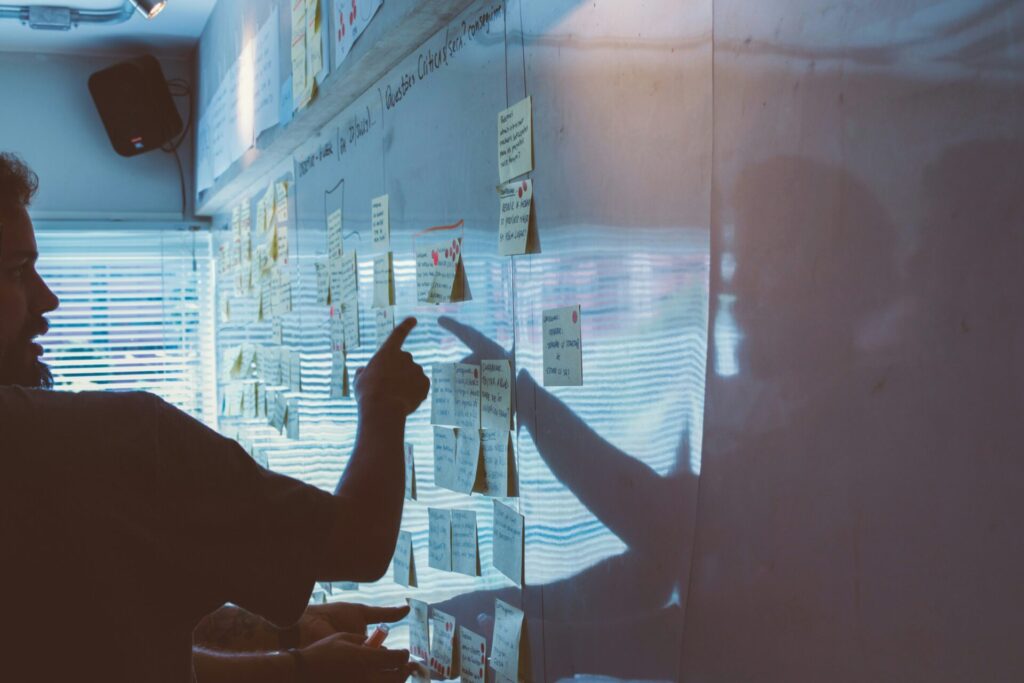ERP Strategy: Essential Topics to Cover Before Your ERP Implementation
Implementing an ERP system is one of the most complex and critical projects a company can undertake. Over the years, I’ve seen many projects succeed, but many of them failed. One of the reasons a project can struggle or even fail, is simply because key topics are not properly addressed early on. Defining a clear ERP strategy is the foundation of success. In this post, I’ll walk you through the essential areas you should cover before you start your ERP implementation and how they fit into your ERP strategy and project plan.

Phase 1: Initiation & Planning – Crafting a Realistic ERP Strategy
Every successful ERP implementation begins with a strong foundation. This first phase of your ERP project plan focuses on setting business goals, assessing readiness, and defining high-level expectations.
Define Your Strategy
Your ERP strategy must be tailored to your business model, goals, and scalability needs. Are you looking to drive digital transformation, enable growth, or reduce system complexity? Perhaps your strategy is focused on compliance, standardization, or cost optimization. Begin with clarity:
- Business goals: What problems are you trying to solve?
- Timeline expectations: Are there seasonal or fiscal deadlines?
- Sponsorship: Is executive leadership fully committed?
- ERP strategy roadmap: What are the priorities and how do you plan to develop your ERP once the initial (core) phase is done?
ERP Consolidation Strategy
Many mid-sized and large organizations operate multiple ERP systems across subsidiaries, departments, or geographical regions. An ERP consolidation strategy can bring considerable benefits:
- Cost reduction by eliminating redundant systems and licenses
- Streamlined operations and more consistent processes
- Unified reporting across the enterprise
- Easier integration with third-party applications
Ask the critical question early: Do we need multiple ERPs, or can we consolidate into a single, scalable solution?
If consolidation is viable, include it as a core pillar of your ERP strategy. Plan for data harmonization, process alignment, and a change management approach across all business units.
Budget Planning
Budgeting is more than just numbers – it sets the tone for the entire implementation. Consider:
- Licensing and subscriptions
- Implementation partner fees
- Internal resources and backfill
- Custom development and integrations
- Data migration and cleansing
- Training and change management
- Contingency planning
An underestimated budget is one of the most common reasons ERP projects fail. Be realistic, transparent, and flexible. My advice is that, when you create the budget, add 10% on top of that, just to be sure you will be able to cover unexpected situations within this budget.
Solution Blueprinting
Once you’ve defined your ERP strategy and validated your budget, it’s time to create a high-level solution blueprint. This includes:
- Core business processes to be supported (finance, supply chain, HR, etc.)
- Organizational scope (which legal entities, departments, countries or locations)
- Integration possibilities with other systems
- Key KPIs and reporting requirements
- Future scalability requirements
This blueprint serves as the architectural vision that guides your ERP project plan going forward.
Phase 2: Solution Design – Bridging Business Needs and Technology
This phase brings your ERP strategy to life by detailing how the solution will operate, integrate, and serve the organization.
Gap Fit and Solution Design
No ERP system will fit 100% of your needs out-of-the-box. Therefore, one of the most critical tasks is conducting a gap fit analysis:
- Identify where your business processes differ from standard ERP functionality.
- Decide whether to adapt the business to the software or customize the software to fit the business.
- Prioritize gaps based on business value and implementation complexity.
Documenting and designing these gap solutions ensures you maintain strategic alignment and avoid scope creep.
Make sure that key users are fully committed in this phase. If not, make sure you find a way to encourage them to become focused and committed.
Integration Architecture
Modern organizations rarely operate with a single system. Your ERP must connect to:
- CRM platforms (e.g., Salesforce, HubSpot)
- Warehouse Management Systems
- Ecommerce systems (both B2B and B2C)
- Banking gateways
- Logistics and shipping providers
- Data warehouses and analytics platforms
Plan your integration strategy carefully:
- Do you need real-time or scheduled integrations?
- API vs file-based? I prefer APIs.
- Are you planning to use middleware or direct connections?
Data Model Design
A solid ERP implementation checklist must include data modeling. Poor master data structure can cripple performance, cause reporting inaccuracies, and confuse end users.
Start early with defining:
- Customer and vendor master data
- Item/product structure
- Chart of accounts and financial dimensions
- Hierarchies and categories
- Units of measure and currency settings
- Global setup (e.g. different posting groups)
- Local setup (VAT-related stuff)
Agree on data ownership and governance policies. Some companies even introduce separate teams that handle master data on a global level. Consistent data definitions across the enterprise are crucial, especially in ERP consolidation strategies, and group reporting.
ERP Reporting Strategy
A modern ERP strategy must include robust reporting and analytics. During solution design, determine the following:
- What are your key performance indicators (KPIs)?
- Will you use embedded reporting or external tools (like Power BI, Tableau)? I suggest that you go with the latter – export your data in some kind of data warehouse or a lakehouse.
- What are the real-time vs. historical reporting needs? Usually the reports are built on data exported the day before. If someone needs real-time reporting, make sure you fully understand the reasons for that.
Design your ERP system not just to transact, but to inform.
Security & Compliance
Security isn’t an afterthought – it must be embedded from the design stage. Your ERP implementation checklist should include:
- Role-based access controls
- Segregation of duties (especially for financial compliance)
- Audit logging and traceability
- Regulatory requirements (GDPR, SOX, etc.)
Think beyond technical access – plan the organizational roles and approval workflows that will ensure control and compliance.
Phase 3: Build & Test – Turning Design into Reality
Now comes the heavy lifting: development, configuration, data migration, and extensive testing.
Development and Configuration
Your team and implementation partner will configure the ERP system according to the solution design. This includes:
- Setting up business rules, workflows, and approval chains
- Building any necessary customizations
- Implementing integrations and APIs
- Creating security roles and user groups
Ensure regular design reviews and demos with business stakeholders to validate progress. Make sure that key stakeholders understand the development and deployment process.
Test Strategy
Testing is often undervalued, but a robust test strategy is non-negotiable in your ERP project plan. Plan and execute:
- Unit testing: Functional testing of individual components
- Integration testing: Ensuring all parts work together
- Performance testing: Can the system handle peak loads?
- User acceptance testing (UAT): Final sign-off by business users
Involve business users early and often in test script development. UAT should simulate real-life business scenarios end to end.
Also, make sure you think about implementing automated testing, so the users don’t have to spend time on testing every time a minor change is made.
Data Migration
Data migration is one of the most difficult parts of ERP implementation. You must:
- Cleanse data from legacy systems
- Map data to the new system’s structure
- Test multiple mock migrations to validate accuracy
- Create a plan and cutover procedures for the final go-live migration
Don’t underestimate the time, effort, and risks related to data. A strong ERP implementation checklist should treat data migration as its own mini-project.
Solution Performance and Scalability
As part of this phase, run performance and volume testing. Ensure your infrastructure (cloud or on-premises) can scale with transaction volumes, number of users, and system integrations.
Phase 4: User Enablement & Go-Live Readiness – Final ERP Implementation Checklist
This phase is all about readiness – both technical and human. Even the best-built ERP will fail if people aren’t prepared to use it.
User Training
Invest in meaningful, role-based training:
- Functional users
- Approvers and managers
- Admin and IT staff
Use a mix of live sessions, e-learning, and hands-on exercises. Avoid generic “click here” trainings – focus on real business processes – make sure that users really understand the processes.
Documentation
Create detailed user manuals, process flows, and troubleshooting guides. These should live in a central knowledge base and be updated post-go-live. Try using AI to implement self-service support portals.
Cutover Planning
A cutover strategy defines how you transition from legacy systems to the new ERP:
- Freeze periods for legacy data
- Final data migration steps
- User credential provisioning
- Communications and status monitoring
- Contingency plans and rollback procedures
Run cutover rehearsals (dry runs) to minimize surprises.
Communication and Change Management
People resist what they don’t understand. Communicate early and often:
- Why the ERP project is happening
- What changes to expect
- How their roles might evolve
- Where to get help
Change champions within each department can ease the transition.
Phase 5: Go-Live & Stabilization – Managing the Transition
Maybe the system is live, but the work is far from over.
Hypercare and Support
Immediately after go-live, enter a hypercare period:
- Daily monitoring and triage of issues
- Dedicated support staff for critical business processes
- Fast escalation paths
- Monitoring for performance degradation or data issues
Hypercare typically lasts 2–6 weeks depending on project size.
Post-Go-Live Reviews
Schedule structured reviews 30, 60, and 90 days after go-live. Capture:
- Outstanding issues
- User feedback and adoption levels
- Reporting gaps
- Enhancement requests
These reviews feed into your continuous improvement roadmap.
Upgrade and Maintenance Strategy
Plan how you will handle future updates, patches, and upgrades. Will you update quarterly or annually? Who will test and validate each update? A sustainable upgrade strategy is a vital component of your long-term ERP strategy. Don’t wait for too long for the next upgrade – the ERP systems are changing fast, and you might end up with a very old system. In that case, you will have to implement ERP again at some point.
Phase 6: Continuous Improvement – Evolving Your Strategy
ERP implementation is not a destination – it’s a journey. Once your system stabilizes, shift your focus to long-term innovation, and try to spend less time on support.
Process Optimization
Use post-go-live insights to optimize:
- Transaction throughput
- Workflow efficiency
- Data quality
- Reporting accuracy
Establish a Center of Excellence (CoE) to manage improvements.
Innovation Roadmap
Explore advanced features and integrations:
- AI-driven forecasting
- Machine learning for predictive analytics
- Robotic Process Automation (RPA)
- Advanced analytics and dashboards
- Supplier/customer portals and/or mobile apps
Let your ERP evolve with your business.
Business Alignment
Revisit your ERP strategy annually to ensure alignment with:
- Strategic business goals and strategic projects for next 1-2 years
- Market conditions
- Regulatory changes
- Emerging technologies
An ERP strategy that stays stagnant quickly becomes a liability.
Final Thoughts on Building Your ERP Implementation Strategy
ERP implementation is not just an IT project – it’s a business transformation. Creating a solid ERP strategy, supported by a detailed ERP project plan and an actionable ERP implementation checklist, will greatly increase your chances of success.
Take the time to plan thoroughly, involve the right stakeholders early, and never underestimate the importance of user training and documentation. Your future self (and your business) will thank you.
If you want to learn How to Choose the Right Software for Your Business, make sure you check this blog post. There is also a great article by ERPFocus on ERP implementation plans.
One book I would recommend when it comes to implementing business software is The Zen of IT: An Enlightened Approach to Business Software Implementation



